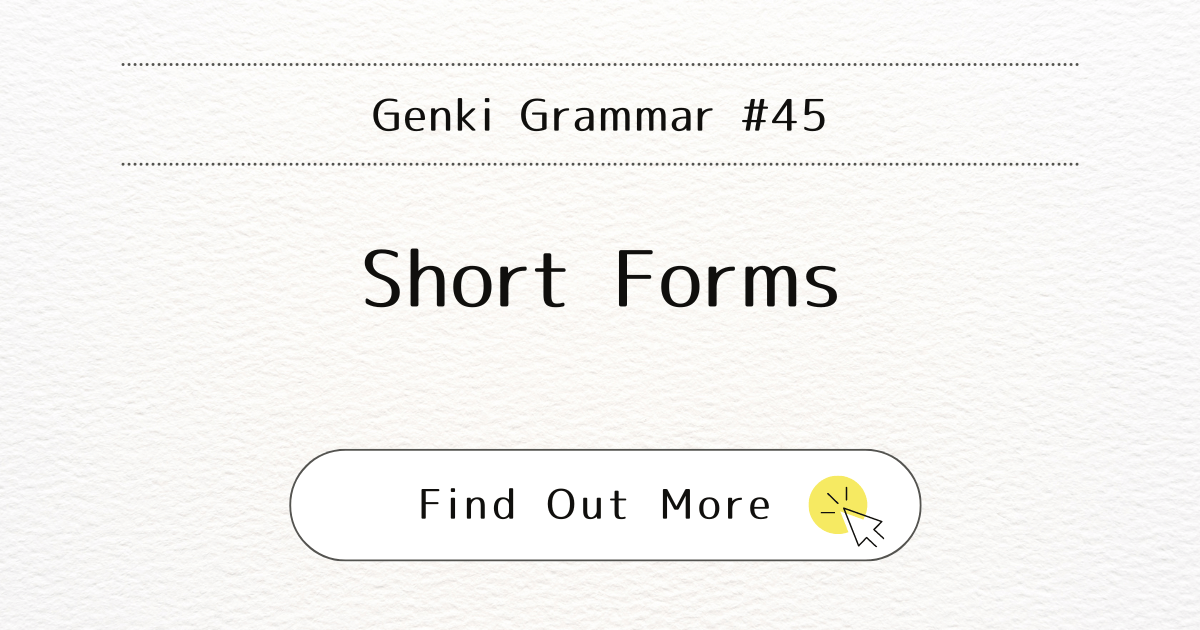
Introduction
In this post, we will learn about a new type of conjugation called “short forms.” These forms are also known as “plain forms,” “informal forms,” or “direct style.” In contrast, the “long forms” we already know are often called “polite forms,” “formal forms,” or “distal style.”
What It Means
Short forms are used in casual, informal conversations, while long forms are used in polite or formal contexts. Understanding both forms is essential for proper communication in different social settings.
Present, Affirmative
- Verbs:
- Long form: 読みます (yomimasu)
- Short form: 読む (yomu) – (Dictionary form)
- い-adjectives:
- Long form: かわいいです (kawaii desu)
- Short form: かわいい (kawaii) – (Drop です)
- な-adjectives:
- Long form: 静かです (shizuka desu)
- Short form: 静かだ (shizuka da) – (Replace です with だ)
- Noun + です:
- Long form: 学生です (gakusei desu)
- Short form: 学生だ (gakusei da) – (Replace です with だ)
Present, Negative
- Verbs:
- Long form: 読みません (yomimasen)
- Short form: 読まない (yomanai)
- い-adjectives:
- Long form: かわいくないです (kawaiku nai desu)
- Short form: かわいくない (kawaiku nai) – (Drop です)
- Exception: いい (ii)
- Long form: よくないです (yoku nai desu)
- Short form: よくない (yoku nai)
- Exception: いい (ii)
- な-adjectives:
- Long form: 静かじゃないです (shizuka ja nai desu)
- Short form: 静かじゃない (shizuka ja nai) – (Drop です)
- Noun + です:
- Long form: 学生じゃないです (gakusei ja nai desu)
- Short form: 学生じゃない (gakusei ja nai) – (Drop です)
Verbs in the Negative
Ru-verbs, u-verbs, and irregular verbs conjugate differently in their short forms.
Verbs Short Forms (Present, Negative)
- Ru-verbs: Drop the final る and add ない.
- 食べる (taberu) → 食べない (tabenai)
- U-verbs: Drop the last -u and add -anai. Verbs that end in う get わ instead of あ.
- 書く (kaku) → 書かない (kakanai)
- 会う (au) → 会わない (awanai)
- Irregular verbs: The vowels change.
- する (suru) → しない (shinai)
- くる (kuru) → こない (konai)
- Exception: The verb ある (aru) is replaced by the adjective ない (nai).
- ある (aru) → ない (nai)
Verb Conjugation Chart
Think of u-verb conjugation as moving up and down in the hiragana chart. Let’s take 書く (kaku) for example. The dictionary form 書く is the combination of the verb base 書 (ka) and the ending く. 書きます (kakimasu) is the combination of 書, き, and the ます ending. 書かない (kakanai) is 書, か, and ない.
| 書 | 話 | 待 | 死 | 読 | 作 | 泳 | 遊 | 買 | ||
| Negative | か | さ | た | な | ま | ら | が | ば | わ | ない |
| Stem | き | し | ち | に | み | り | ぎ | び | い | ます |
| Affirmative | く | す | つ | ぬ | む | る | ぐ | ぶ | う | Dictionary form |
Note that we have 買わない (kawanai) with わ instead of あ, because the bases of u-verbs ending with う (u) actually end with the consonant w, which remains silent in 買う ( kau) and 買います (kaimasu), but appears again in 買わない (kawanai).
Conclusion
Understanding short forms is crucial for speaking Japanese casually and informally.



